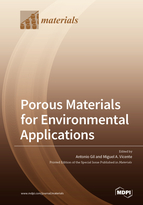Porous Materials for Environmental Applications
A special issue of Materials (ISSN 1996-1944). This special issue belongs to the section "Porous Materials".
Deadline for manuscript submissions: closed (31 August 2019) | Viewed by 36791
Special Issue Editors
Interests: preparation, characterization, and catalytic activity of metal-supported catalysts; surface properties of solids; pollutants adsorption; environmental management; industrial waste valorization
Special Issues, Collections and Topics in MDPI journals
Interests: clay-based materials; preparation, characterization, and catalytic activity of metal supported nanocatalysts; surface properties of solids; pollutants adsorption; environmental management
Special Issues, Collections and Topics in MDPI journals
Special Issue Information
Dear Colleagues,
The development of porous materials has attracted the attention of the research community for years. Porosity characteristics have specific impacts on material properties, and materials are applied in several areas, such as pollutant removal, CO2 capture, energy storage, catalytic oxidation and reduction processes, conversion of biomass to biofuels, and drug delivery. Examples of porous materials are activated carbons, clays, and zeolites, among others. The aim of this Special Issue is to collect recent advances and progress, developed considering porous materials and their applications in environmental areas.
Prof. Dr. Antonio Gil
Prof. Dr. Miguel A. Vicente
Guest Editors
Manuscript Submission Information
Manuscripts should be submitted online at www.mdpi.com by registering and logging in to this website. Once you are registered, click here to go to the submission form. Manuscripts can be submitted until the deadline. All submissions that pass pre-check are peer-reviewed. Accepted papers will be published continuously in the journal (as soon as accepted) and will be listed together on the special issue website. Research articles, review articles as well as short communications are invited. For planned papers, a title and short abstract (about 100 words) can be sent to the Editorial Office for announcement on this website.
Submitted manuscripts should not have been published previously, nor be under consideration for publication elsewhere (except conference proceedings papers). All manuscripts are thoroughly refereed through a single-blind peer-review process. A guide for authors and other relevant information for submission of manuscripts is available on the Instructions for Authors page. Materials is an international peer-reviewed open access semimonthly journal published by MDPI.
Please visit the Instructions for Authors page before submitting a manuscript. The Article Processing Charge (APC) for publication in this open access journal is 2600 CHF (Swiss Francs). Submitted papers should be well formatted and use good English. Authors may use MDPI's English editing service prior to publication or during author revisions.
Keywords
- Activated Carbons
- Clays
- Hydrotalcite-Like Compounds
- Metal-Organic Frameworks (MOFs)
- Nanoporous Materials
- Ordered Mesoporous Materials: Pillared Interlayered Clays (PILCs)
- Polymers
- Zeolites and Zeolite-Like Materials
- Adsorption Applications
- Air Pollution Control: Catalytic Applications
- Purification/Separation of Gases and Liquids
- Removal of Pollutants
- Sensors
- Wastewater Treatment








